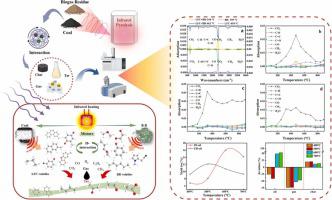当前位置:
X-MOL 学术
›
Process Saf. Environ. Prot.
›
论文详情
Our official English website, www.x-mol.net, welcomes your feedback! (Note: you will need to create a separate account there.)
Enhanced energy efficiency and fast co-pyrolysis characteristics of biogas residues and long-flame coal using infrared heating and TG-FTIR-MS
Process Safety and Environmental Protection ( IF 6.9 ) Pub Date : 2024-06-19 , DOI: 10.1016/j.psep.2024.06.084 Yongfu Zeng , Zuohua Liu , Jianglong Yu , Erfeng Hu , Shuai Li , Xin Jia , Yishui Tian , Chao Wang
Process Safety and Environmental Protection ( IF 6.9 ) Pub Date : 2024-06-19 , DOI: 10.1016/j.psep.2024.06.084 Yongfu Zeng , Zuohua Liu , Jianglong Yu , Erfeng Hu , Shuai Li , Xin Jia , Yishui Tian , Chao Wang

|
Co-pyrolysis may enhance the energy efficiency of anaerobic digestion waste (biogas residues), while simultaneously facilitating the clean utilization of coal. A thermogravimetric analyzer (TG), TG-FTIR-MS, and infrared heating technique were employed to investigate the rapid co-pyrolysis properties of long-flame coal (LFC) and biogas residues (BR) in this study. Meanwhile, the effects of temperature on the co-pyrolysis product distributions and compositions were studied in reactors that were heated with electric heating and rapid infrared heating. The co-pyrolysis of LFC and BR had the potential to decrease greenhouse gas emissions, as indicated by the TG-FTIR/MS findings. The co-pyrolysis kinetics were calculated using two models (KAS and FWO); the average values are 176.09 and 187.26 kJ/mol, respectively. Tar yields increased initially in IH (electric heating) and EH (infrared heating) reactors, before declining as the temperature rose. The tar yields are greatest for EH at 500 °C (16.12 wt%) and IH at 600 °C (16.02 wt%). Tar yields generated via infrared heating were greatly higher than those generated by EH at 600–700 ℃. IH has a higher tar yield due to the fact that there are significant synergistic effects between coal and lignin, protein, and lipid at high temperatures. The GC-MS results indicate that IH has promoted the aromatization and ketonization reactions. Moreover, more monocyclic aromatic and bicyclic aromatic products are generated by infrared heating, suggesting an indication of tar quality improvement. An elevated co-pyrolysis temperature results in a greater degree of graphitization in char.
中文翻译:

利用红外加热和 TG-FTIR-MS 提高沼渣和长焰煤的能源效率和快速共热解特性
共热解可以提高厌氧消化废物(沼渣)的能源效率,同时促进煤炭的清洁利用。本研究采用热重分析仪(TG)、TG-FTIR-MS和红外加热技术研究了长焰煤(LFC)和沼渣(BR)的快速共热解特性。同时,在电加热和快速红外加热的反应器中研究了温度对共热解产物分布和组成的影响。 TG-FTIR/MS 结果表明,LFC 和 BR 的共热解具有减少温室气体排放的潜力。使用两个模型(KAS 和 FWO)计算共热解动力学;平均值分别为 176.09 和 187.26kJ/mol。 IH(电加热)和 EH(红外加热)反应器中的焦油产量最初增加,然后随着温度升高而下降。 EH 在 500 °C 时焦油产率最高(16.12wt%),IH 在 600 °C 时焦油产率最高(16.02wt%)。在600~700 ℃下,红外加热产生的焦油产率远高于EH产生的焦油产率。由于煤与木质素、蛋白质、脂质在高温下存在显着的协同效应,IH具有较高的焦油产率。 GC-MS结果表明IH促进了芳构化和酮化反应。此外,通过红外加热产生更多的单环芳香族和双环芳香族产物,这表明焦油质量得到改善。升高的共热解温度导致炭中更大程度的石墨化。
更新日期:2024-06-19
中文翻译:

利用红外加热和 TG-FTIR-MS 提高沼渣和长焰煤的能源效率和快速共热解特性
共热解可以提高厌氧消化废物(沼渣)的能源效率,同时促进煤炭的清洁利用。本研究采用热重分析仪(TG)、TG-FTIR-MS和红外加热技术研究了长焰煤(LFC)和沼渣(BR)的快速共热解特性。同时,在电加热和快速红外加热的反应器中研究了温度对共热解产物分布和组成的影响。 TG-FTIR/MS 结果表明,LFC 和 BR 的共热解具有减少温室气体排放的潜力。使用两个模型(KAS 和 FWO)计算共热解动力学;平均值分别为 176.09 和 187.26kJ/mol。 IH(电加热)和 EH(红外加热)反应器中的焦油产量最初增加,然后随着温度升高而下降。 EH 在 500 °C 时焦油产率最高(16.12wt%),IH 在 600 °C 时焦油产率最高(16.02wt%)。在600~700 ℃下,红外加热产生的焦油产率远高于EH产生的焦油产率。由于煤与木质素、蛋白质、脂质在高温下存在显着的协同效应,IH具有较高的焦油产率。 GC-MS结果表明IH促进了芳构化和酮化反应。此外,通过红外加热产生更多的单环芳香族和双环芳香族产物,这表明焦油质量得到改善。升高的共热解温度导致炭中更大程度的石墨化。











































 京公网安备 11010802027423号
京公网安备 11010802027423号